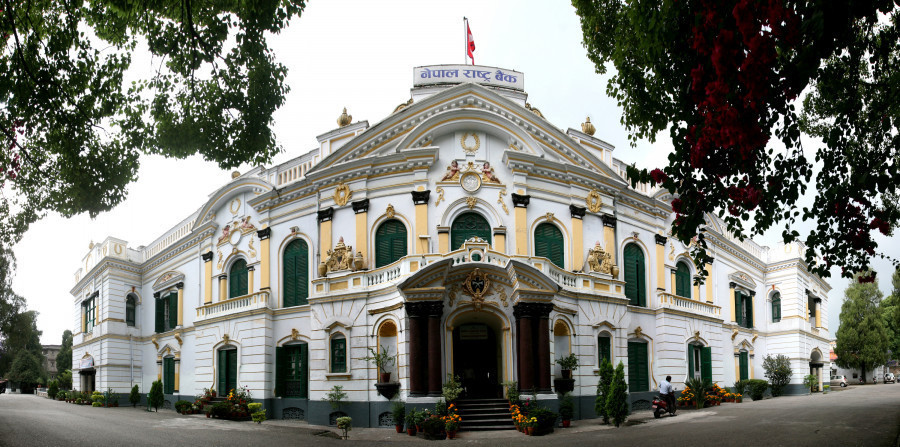Columns
NRB’s autonomy in question
It is not the job of regulators such as the central bank to wish for higher stock prices.
Paban Raj Pandey
Nepal Rastra Bank is being pushed to the wall. Self-serving elements are putting undue pressure on the central bank to end a policy rightly set in place two years ago to stop snorting equity bulls from taking on excessive leverage. Investor sentiment was dangerously exuberant then; it is dispirited now. It is possible it is time to gradually phase out the policy—or at least make some changes to dilute its effect. That is not the issue. The issue is the way in which attempts are being made to influence the decision-making process of an independent entity. Investors have for a long time been clamouring for getting rid of the policy. They are now joined by finance ministers—former and present.
The issue revolves around a policy instituted by the 2021-22 monetary policy, announced in July 2021, limiting margin loan per customer to Rs40 million at one bank and Rs120 million at multiple banks. The policy was amended in July 2022 with the 2022-23 monetary policy allowing Rs120 million per individual from one or multiple banks. Leading up to this year’s monetary policy, investors were confident that Nepal Rastra Bank would get rid of the policy. The Nepal Stock Exchange (NEPSE) began to rally from 1808 on May 15 this year. The 2023-24 monetary policy, announced on July 23, made no changes. The NEPSE peaked at 2244 on July 24, troughing at 1931 on September 7.
In 2021, shortly after Nepal Rastra Bank tightened its margin loan policy, the NEPSE peaked intraday at 3227 on August 19, having nearly tripled from March 5, 2019, when it bottomed at 1099. Hindsight is always 20/20, but the margin restriction probably acted as a catalyst in pricking the prevailing bubble in the stock market. At the peak in August 2021, the NEPSE boasted a market capitalisation of just under Rs4.3 trillion, while the daily turnover exceeded Rs20 billion in three sessions, with an all-time high of Rs21.6 billion on the 15th. The market cap currently is around Rs3 trillion, which equates to 64 percent of the gross domestic product, and the daily turnover has shrunk to around Rs2 billion.
Setting bad precedent
If Nepal Rastra Bank did not proactively act, the bubble likely would continue to inflate, and the eventual drop would exact bigger pain and suffering. Bubbles are intoxicating—until they burst. From its high, the NEPSE tumbled 44 percent to bottom at 1807 on June 24, 2022. That low was successfully tested on September 25, 2022, when the index tagged 1812, and again on May 15 this year. Bulls cannot afford to lose 1800. The index currently hovers around 2000 but has not been able to lift meaningfully off 1800. Fundamentally, the economy continues to be in the doldrums. Investors seem desperate for a positive catalyst. Hence the pressure on Nepal Rastra Bank to get rid of the margin loan policy.
Nepal Rastra Bank was condemned for reining in margin growth from the very beginning. Criticism has gone up of late. In the past month or two, politicians have joined the chorus. Some prominent names include Surendra Pandey and Dr Yuba Raj Khatiwada, who are both former finance ministers, with the latter also having served as Nepal Rastra Bank governor. In public forums recently, both commented that the Rs120-million cap is no longer needed. Pandey even advised Dr Prakash Sharan Mahat, the present finance minister, to ask Maha Prasad Adhikari, Nepal Rastra Bank governor, to take the blame and undo the damage. Mahat has requested Adhikari to be flexible about the Rs120-million cap.
There are a couple of issues here. First, increasingly it feels like Adhikari is cornered. The Nepal Rastra Bank Act 2002 ensures autonomy to the central bank, but because of the way the board is set up and so forth, it also leaves room for interference. The board consists of the governor, the finance secretary, two deputy governors, and three members appointed by the government of Nepal. In other words, it is a four to three in favour of the government. Mahat will have his way should push come to shove. The faux pas he has committed is the way this is being handled. Mahat is a sitting finance minister and should not wash his dirty linen in public. This sets a bad precedent and puts the “autonomous” central bank in a bad light.
Margin debt cuts both ways
Secondly, the whole purpose of trying to get the Rs120-million cap scrapped is to push stocks higher. Bulls are hoping a lenient margin policy will act as a tailwind for the stuck-in-the-mud NEPSE. It very well may initially. The risk is what it might lead to. Nepali investors just went through an ordeal. Margin debt at banks and financial institutions was Rs40.9 billion in March 2019; by the time the NEPSE peaked in August 2021, it had surged to Rs108.6 billion. In good times, margin debt greases the wheels of the stock market, but it cuts both ways. Gains get multiplied, but so do losses. Just ask the investors who faced margin calls as the NEPSE tumbled 44 percent. Margin loan was Rs76.4 billion mid-August.
It is not the job of regulators such as Nepal Rastra Bank to wish for higher stock prices. Rather, often, they step up and shut down rowdy parties; they need to, just so the hangover is manageable. Politicians are a different breed. Their whole behaviour is dictated by the next election cycle. By nature, they take credit when things are going well and shift the blame when they are not. Adhikari is being scapegoated—plain and simple. A lenient margin loan policy may help stocks in the short term, but ultimately the NEPSE will reflect the economy—not only the present but where it is headed. In this respect, investors are not too excited about growth prospects—thus handing out a failing grade.
Confrontation between central banks and the executive branch is not that uncommon. We often hear of such instances even in developed nations such as the United States and Japan as well as emerging economies like India. Nepal’s is a little different. It is a young democracy. The NEPSE only began trading in January 1994. This is the time to lay the foundation. Nepal Rastra Bank definitely does not want to give an impression that it effortlessly wilts under pressure. In central banking, signalling plays as important a role as the actual action itself. For now, Adhikari is likely to raise the cap to, say, Rs160 million—ideal if he waits until the first-quarter review in November. But in no circumstances should he scrap the policy.




 15.12°C Kathmandu
15.12°C Kathmandu















